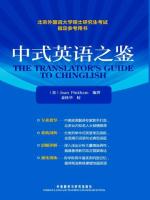A Timeless Handbook for Translators and Learners Alike
用户826330
The Translator’s Guide to Chinglish by Joan Pinkham is a
groundbreaking resource that delves deep into the intricacies of
Chinglish—the hybrid language form born from the collision of Chinese
and English linguistic habits. Pinkham, an experienced American
translator with years of hands-on experience refining Chinese
translators’ work, masterfully dissects Chinglish through meticulous
categorization and vivid examples. The book’s strength lies in its
systematic structure. Divided into three main sections, it first
addresses “Excessive Words,” exposing how Chinese speakers often overuse
nouns, verbs, and modifiers in English. For instance, phrases like “make
an improvement” (simplified to “improve”) or “carry out investigations”
(better as “investigate”) exemplify redundant expressions rooted in
literal translations. The second section focuses on “Sentence
Structure,” critiquing issues such as “noun clusters” (e.g., “the
implementation of the plan’s adjustment” instead of “adjusting the
plan”). Pinkham’s analysis extends beyond grammar, highlighting the
cultural and cognitive differences driving these mistakes. Finally, the
book concludes with practical exercises and model revisions, bridging
theory and application seamlessly. One of the book’s most valuable
contributions is its emphasis on the “thought process” behind Chinglish.
Pinkham argues that it’s not merely a language error but a result of
Chinese speakers subconsciously applying their native language’s logic
and syntax to English. For example, Chinese sentences often omit
subjects, while English requires explicit references. By understanding
these fundamental disparities, readers learn to think in English rather
than translate directly, a skill crucial for both students and
professional translators. However, the book’s examples predominantly
focus on formal writing, such as government reports and academic texts,
leaving room for a more comprehensive exploration of Chinglish in casual
or colloquial contexts. Additionally, some expressions might feel dated,
reflecting language evolution since the book’s publication. Overall,
The Translator’s Guide to Chinglish remains an indispensable tool for
anyone aiming to elevate their English proficiency, offering both
immediate solutions and long-term strategies to break free from
Chinglish’s constraints.



 京公网安备 11010802032529号
京公网安备 11010802032529号